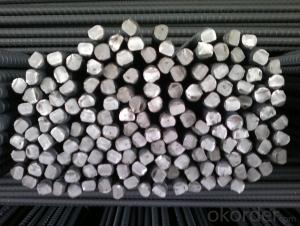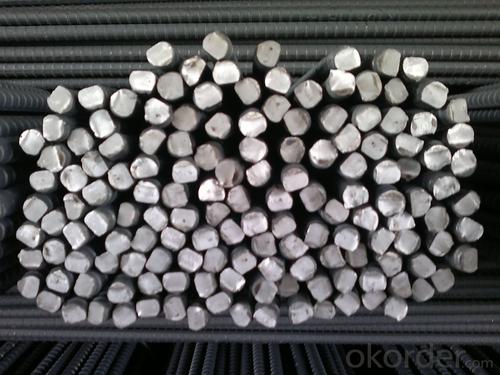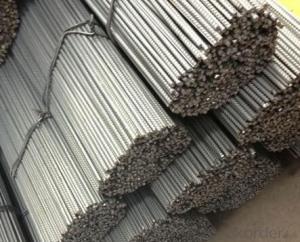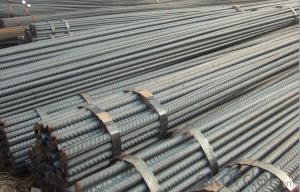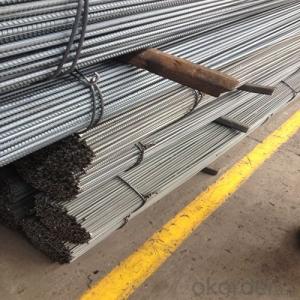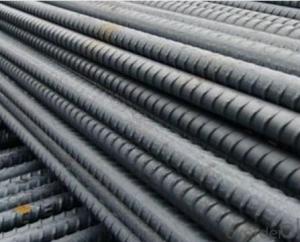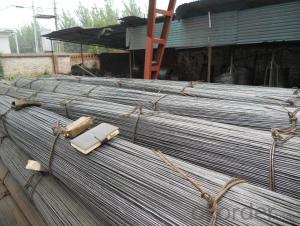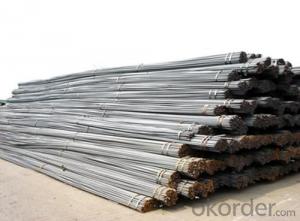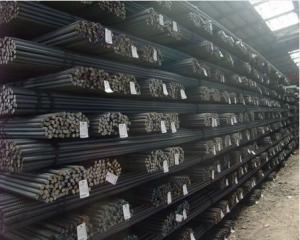High Quality ASTM Standard Deformed Steel Rebar
- Loading Port:
- China main port
- Payment Terms:
- TT or LC
- Min Order Qty:
- 50 m.t.
- Supply Capability:
- 200000 m.t./month
OKorder Service Pledge
OKorder Financial Service
You Might Also Like
Product Description:
Specifications of High Quality ASTM Standard Deformed Steel Rebar
Standard | GB | HRB335, HRB400, HRB500 | |
UK | G460B, B500A, B500B,B500C | ||
USA | GR40, GR60 | ||
Diameter | 6mm,8mm,10mm,12mm,14mm,16mm,18mm,20mm, 22mm,25mm,28mm,32mm,36mm,40mm,50mm | ||
Length | 6M, 9M,12M or as required | ||
Place of origin | Hebei, China mainland | ||
Application | building,construction,road,bridge etc | ||
Brand name | DRAGON | ||
Theoretical weight and section area of each diameter as below for your information:
Diameter(mm) | Section area (mm²) | Mass(kg/m) |
6 | 28.27 | 0.222 |
8 | 50.27 | 0.395 |
10 | 78.54 | 0.617 |
12 | 113.1 | 0.888 |
14 | 153.9 | 1.21 |
16 | 201.1 | 1.58 |
18 | 254.5 | 2.00 |
20 | 314.2 | 2.47 |
22 | 380.1 | 2.98 |
25 | 490.9 | 3.85 |
28 | 615.8 | 4.83 |
32 | 804.2 | 6.31 |
36 | 1018 | 7.99 |
40 | 1257 | 9.87 |
50 | 1964 | 15.42 |
Usage and Applications of High Quality ASTM Standard Deformed Steel Rebar
Deformed bar is widely used in buildings, bridges, roads and other engineering construction. Big to highways, railways, bridges, culverts, tunnels, public facilities such as flood control, dam, small to housing construction, beam, column, wall and the foundation of the plate, deformed bar is an integral structure material. With the development of world economy and the vigorous development of infrastructure construction, real estate, the demand for deformed bar will be larger and larger..
Packaging & Delivery of High Quality ASTM Standard Deformed Steel Rebar
Packaging Detail: products are packed in bundle and then shipped by container or bulk vessel, deformed bar is usually naked strapping delivery, when storing, please pay attention to moisture proof. The performance of rust will produce adverse effect.
Each bundle weight: 2-3MT, or as required
Payment term: TT or L/C
Delivery Detail: within 45 days after received advanced payment or LC.
Label: to be specified by customer, generally, each bundle has 1-2 labels
Trade terms: FOB, CFR, CIF
Deformed Steel Bar in Coil
Produce Line of High Quality ASTM Standard Deformed Steel Rebar
Note:
1. Our products are produced according to national standard (GB), if not, supply according to national standards (GB) or agreement as customer required.
2. Other Grade and Standard Deformed Steel Bar we can supply:
Grade: GR40/GR60, G460B/B500A/B500B/B500C,BST500S
Standard: ASTM, BS, DIN
The Minimum Order Quantity of these products is high, and need to be confirmed.
3. We can not only supply Deformed Steel Bar; if you need anything about building materials, please contact us for further information.
4. Please send us your detail specifications when inquire. We will reply to you as soon as possible. We sincerely hope we can establish a long stable business relationship
Pictures of High Quality ASTM Standard Deformed Steel Rebar
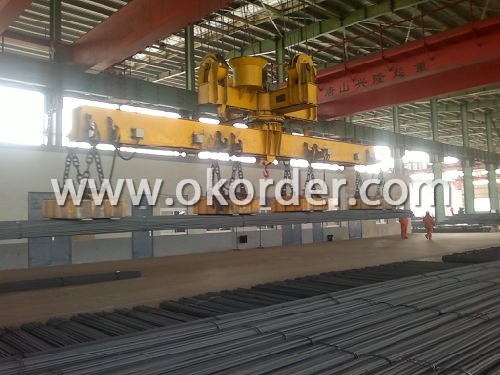
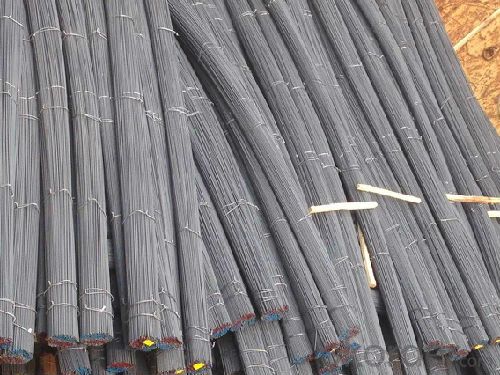
Deformed Steel Bar in testing
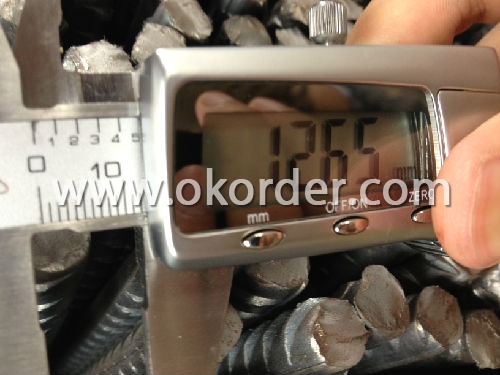
- Q: How do steel rebars affect the durability of a concrete structure?
- Steel rebars greatly enhance the durability of a concrete structure. By providing tensile strength to the concrete, rebars prevent cracking and improve resistance to external forces such as earthquakes and heavy loads. They also help in reinforcing the structure and preventing deterioration caused by corrosion. Overall, steel rebars play a vital role in enhancing the longevity and structural integrity of concrete constructions.
- Q: How do steel rebars provide reinforcement to concrete?
- Steel rebars provide reinforcement to concrete by adding strength and durability to the structure. When embedded within the concrete, rebars act as tension members, resisting forces that would otherwise cause cracking or failure. The high tensile strength of steel rebars helps to distribute and absorb load, enhancing the overall structural integrity of the concrete.
- Q: How are steel rebars bundled and tied together on construction sites?
- Rebar tying, a specific technique employed in construction sites, is the process by which steel rebars, commonly utilized to reinforce concrete structures, are bundled and secured. This practice guarantees the stability and position of the rebars during activities such as concrete pouring. To bundle the rebars, construction workers gather a predetermined number based on the project's specifications and align them in parallel. They then employ wire or steel straps to bind the rebars tightly, creating a compact bundle. These straps are wrapped around the rebars at regular intervals, ensuring the bundle remains intact and the rebars remain in place. Once bundled, the rebars are further secured using specialized tools. The primary tool used for rebar tying is a rebar tying gun or tier. This tool automates the tying process by swiftly twisting wire around the rebars, forming secure connections. Rebar tying guns or tiers are equipped with a spool of wire that is fed through the tool. The construction worker positions the tool above the rebars, activates a trigger or button, and the tool automatically twists the wire around the rebars, tying them together. This process is repeated at regular intervals along the length of the rebars to ensure a secure fastening. The wire used for rebar tying is typically a thin, high-tensile steel wire designed to withstand the exerted forces during construction. This wire, specifically manufactured for rebar tying, is available in pre-cut lengths or on spools. Overall, the bundling and tying of steel rebars on construction sites play a critical role in ensuring the structural integrity of concrete structures. By utilizing wire or steel straps, along with specialized rebar tying tools, construction workers can create secure bundles of rebars, preventing any movement or separation during construction activities.
- Q: What are the common quality control tests for steel rebars?
- Steel rebars undergo several quality control tests to ensure they meet industry standards and specifications. These tests assess the rebars' physical, mechanical, and chemical properties to guarantee their durability and performance. Common quality control tests for steel rebars include: 1. Tensile Test: This test determines the rebars' tensile strength, yield strength, and elongation. It involves gradually applying force to the rebar until it breaks, measuring the maximum force it can withstand. 2. Bend Test: This test evaluates the rebars' ability to withstand bending without cracking. The rebar is bent to a specific angle and inspected for visible cracks. 3. Chemical Composition Analysis: This test determines the rebars' chemical composition, ensuring they meet required standards. It involves analyzing the levels of carbon, manganese, phosphorus, sulfur, and other elements. 4. Visual Inspection: This test visually examines the rebars for surface defects like cracks or irregularities that could impact structural integrity. 5. Dimensional Inspection: This test verifies the rebars' dimensions and shape, checking for deviations from specified requirements. Instruments are used to measure diameter, length, and shape. 6. Weldability Test: If the rebars will be welded, a test is performed to assess their suitability for welding. The quality of the weld joint, including strength and brittleness, is evaluated. 7. Corrosion Resistance Test: This test determines the rebars' resistance to corrosion, which is crucial for long-term durability. It involves subjecting the rebars to accelerated corrosion conditions and assessing their resistance. These tests are essential in ensuring the quality and reliability of steel rebars used in construction projects. Manufacturers and inspectors can identify non-compliant or substandard rebars through these tests, ensuring the safety and structural integrity of buildings and infrastructure.
- Q: What does "4E" mean on the rebar?
- Hrb400e refers to three earthquake resistant steel bars. Compared with the ordinary reinforced phase, the biggest advantage is that the tensile strength and elongation are relatively large, for example, the tensile strength of common grade HRB400 three reinforcement requirements of more than 400 MPa; if hrb400e is aseismic reinforcement, the tensile strength is more than 550MPa.
- Q: Can steel rebars be used in underground parking structures?
- Yes, steel rebars can be used in underground parking structures. They are commonly used in the construction of reinforced concrete structures, including underground parking decks, to provide additional strength and durability to the concrete. Steel rebars help to reinforce the concrete and enhance its load-bearing capacity, making them essential components in underground parking structures.
- Q: How are steel rebars connected together in construction?
- Steel rebars are commonly connected together in construction using various methods such as overlapping, welding, or using mechanical rebar connectors. The specific method chosen depends on the structural requirements and the type of construction being carried out.
- Q: What is the effect of chloride ions on steel rebars?
- The presence of chloride ions in the environment can have a detrimental effect on steel rebars. Chloride ions can penetrate the protective oxide layer on the surface of the steel and react with the iron atoms, leading to the formation of iron chloride compounds. These compounds are highly corrosive and can cause the rebars to rust and eventually weaken. This corrosion process, known as chloride-induced corrosion, can significantly reduce the structural integrity and lifespan of steel rebars, posing a risk to the overall stability of reinforced concrete structures. Therefore, it is crucial to protect steel rebars from chloride exposure through proper design, construction, and maintenance practices to ensure their long-term durability and safety.
- Q: What is the carbon content of thread steel?
- It is understood that carbon is the main element determining the performance of steel, because changes in carbon content directly lead to changes in crystal structure. With the increase of carbon content, the strength and hardness of the threaded steel increase, while the plasticity and toughness decrease. When the carbon content is more than 1%, the strength of the rebar decreases. The increase of carbon content also reduces the weldability and corrosion resistance of steel, and increases the cold brittleness and aging tendency of steel.
- Q: What are the different types of coatings available for steel rebars to prevent corrosion?
- There are several types of coatings available for steel rebars to prevent corrosion. These include epoxy coatings, zinc coatings, galvanized coatings, and polyethylene coatings. Each coating has its own unique properties and level of protection against corrosion.
Send your message to us
High Quality ASTM Standard Deformed Steel Rebar
- Loading Port:
- China main port
- Payment Terms:
- TT or LC
- Min Order Qty:
- 50 m.t.
- Supply Capability:
- 200000 m.t./month
OKorder Service Pledge
OKorder Financial Service
Similar products
Hot products
Hot Searches
Related keywords
